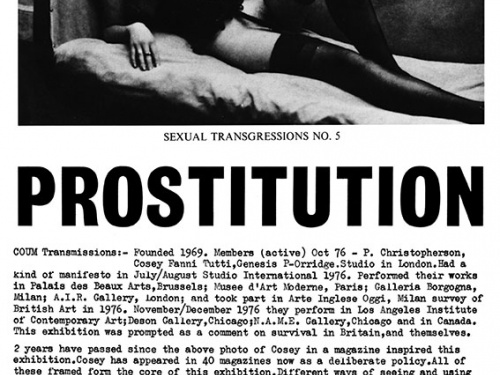Embodying The Queer
The ICA as a historically queer space
Graysen Hall is a student on the ICA's MA in the Contemporary programme. Here he discusses the ICA's history of championing queer art and artists.
The ICA is not an exclusively queer space, existing exclusively for queer artists and queer art. Nonetheless it has continued to make a courageous effort to represent queer art and artists ever since Kenneth Anger’s films were first shown in 1955, just eight years after the ICA was founded and at a time when homosexuality was still illegal in the UK. Anger’s film work, the theatre performances of the Gay Sweatshop troupe, the Cultural Impact of AIDS conference and the New Queer Cinema Conference, among many others, have all been part of the development of the ICA as a space that can embody the queer.
The ICA does not shy away from controversial topics. COUM Transmission and Cosey Fanni Tutti’s Prostitution in 1976 presented pornographic art and utilised props such as tampons and meat cleavers and illicited reactions of shock and horror. Though this piece was not overtly queer in nature, by undermining what was observed to be a taboo, heteronormative subject and placing it right under the public’s nose, it embodied many elements of what it means to be queer. This was not without consequence. The Arts Council responded with threats of reduced funding and the collection was removed from display after only eight days. It was therefore a daring move on the ICA’s part to enlist the Gay Sweatshop Theatre Company to perform later in the very same year that Prostitution was axed.
The ICA has continued to make a courageous effort to represent queer art and artists.
The Gay Sweatshop troupe produced performances with the purpose to "make heterosexuals aware of the oppression they exercise or tolerate, and expose and end media misrepresentations of homosexuals". Despite being rejected for Arts Council funding, the troupe’s established popularity brought a whole new audience to the ICA and they produced a season of performances named Homosexual Acts. A total of seven thousand individuals came to witness the season of performances which, despite being centred around the life of homosexuals, did not shock the press and public in the same way the same way that Prostitution had done months earlier. And it was not the performances alone that provided the connection with the public as an audience, but also discussions that followed them. The ICA offered an open invitation for the public to respond to the shows: breaking the fourth wall and attempting to strengthen the understanding of what it was like to be queer during the 1970s.
Despite the success of Homosexual Acts and other queer art during the 1970s, the AIDS epidemic of the 1980s threatened to reverse the freedoms that gay men and women had won in previous decades, and the Gay Sweatshop group were unable to continue performing during the 1980s due to lack of funding. Nevertheless, the ICA responded to the AIDS epidemic in 1988 by holding a conference exploring the disease's cultural impact: Taking Liberties: AIDS and Cultural Politics. Ekow Eshun writes in How Soon Is Now: 60 Years of the Institute of Contemporary Arts that "the arts offered one of the few spaces where AIDS could be confronted and discussed". By bringing the subject of HIV and AIDS into the spotlight in a way that allowed the truth to be discussed, the ICA disseminated an outlook on the condition and its victims which contradicted a damning common public opinion.
By bringing the subject of HIV and AIDS into the spotlight in a way that allowed the truth to be discussed, the ICA disseminated an outlook on the condition and its victims which contradicted a damning common public opinion.
The ICA has always worked to combat what Ruby B. Rich termed the constant and ‘historic invisibility’ of queer folk, their voices and their art. The New Queer Cinema conference in 1992 provided an incredible opportunity to talk about the queer art world as it stood, as well as to discuss the development of what it meant to be queer and how it had gained the status it had achieved. The conference was the ICA’s opportunity to present an open forum for discussion around the development of cinema and for the public to create a dialogue with artists in relation to their work and their opinions on the subject of the queer. Artists discussed with the audience what the queer had represented for them and their work, as well as how their careers had developed while working both with and without the ICA. With open forums such as this, the queer population and those who wish to be allies have been able to interact directly with the creators of queer and queering art.
The ICA continues to be a space for queer artists. In 2011 it presented a two week exhibition of films and events dedicated to filmmaker Jack Smith, who during his lifetime stood against conventions and produced camp, exciting works, and last year Cary Kwok produced an overtly queer original artists' edition for the ICA's 70th anniversary.
The ICA presents itself as a part-time queer space, opening up the art world for many queer, closeted and simply controversial artists. Over the decades the variety of formats for queer art works has increased, and the ICA has curated them perfectly. ■
This article is posted in: Articles
Tagged with: Queer History, Heritage, LGBTQ, Gay Sweatshop, Kenneth Anger, Jack Smith, LGBT History, Queer Cinema
/index.png?itok=qcQMXTv9)




